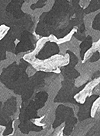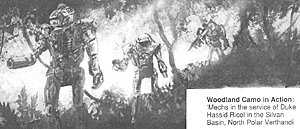 Editor's Note: BattleMechs are designed to fight in a wide range of environments. Since their introduction in combat, these remarkable war machines have served and fought in every conceivable type of surroundings: fetid swamps and jungles, rugged mountains and uplandplateaus, harsh deserts and eroded badlands, glaciers and planetary ice caps, cities, forests, the strangely-shaped
and -colored landscapes of alien worlds, and even on the surfaces of airless moons.
Editor's Note: BattleMechs are designed to fight in a wide range of environments. Since their introduction in combat, these remarkable war machines have served and fought in every conceivable type of surroundings: fetid swamps and jungles, rugged mountains and uplandplateaus, harsh deserts and eroded badlands, glaciers and planetary ice caps, cities, forests, the strangely-shaped
and -colored landscapes of alien worlds, and even on the surfaces of airless moons.
Right: Green Woodland Camo #1: grays, greens, and browns in overlapping, irregular shapes break up the 'Mech's outline and create the impression of sunlight and forest vegetation.
As any warrior can tell you, camouflage pays a vital role in any unit's combat preparedness. While it may be impossible to conceal a BattleMech from an enemy-the thing is 10 meters tall, after all, and devilishly hard to hide--the intelligent use of camouflage can break up a 'Mech's outline, can distract or confuse the enemy, and may even provide a MechWarrior with that all-important extra half-second of reaction time in which to maneuver or fire.
Some MechWarriors deliberately use paint schemes which could be described as the very antithesis of camouflage-Kerensky's black Warhammer and Cherenkoffs red Atlas are examples-with the idea that since it is impossible to hide a 'Mech, a highly visible and easily recognizable color scheme might frighten enemy 'Mech pilots and convince them that continued resistance is useless.
This is the first of a continuing series of essays on the use of paint in BattleMech warfare. Each essay will examine a different camouflage or paint scheme, describe the environments in which it can best be put to use, discuss possible tactical and psychological aspects of certain color or camo schemes as used by Mech Warriors past and present, and attempt to evaluate each scheme's effectiveness in combat. ft is hoped that Mech Warriors among the readers of Battle Technology will find useful ideas for painting their own 'Mechs. Even those readers who get no closer to a BattleMech than a tactical simulator gaming table may find useful guides here for coloring their holographic projections or models.
 GREEN WOODLAND CAMO #1
GREEN WOODLAND CAMO #1
It is likely that the first camouflage ever used in organized warfare was a variant of woodland green--a broken pattern of greens and browns designed to blend in with the leaves and underbrush of a forested background. The pattern described here as Green Woodland Camo #1 is fairly typical of a number of such color schemes. Properly used, it can be highly effective in densely forested or jungle areas.
WORLDS AND ENVIRONMENTS
All standard terrestrial worlds exhibit the same variety and diversity of environmental regions as Man's homeworld. All have the equivalent of forests and jungles, dense masses of vegetation which are vital to the world's oxygen- C02 cycle. The basic green chlorophyll molecule or one of several score chlorophyll analogues has evolved time and again on hundreds of planets across the Inner Sphere. Though details such as the shape of the leaf or of the entire tree will vary tremendously from world to world, the environment of the deep woods or jungle-dimly [it, heavily colored in greens and blue greens and yellows-is repeated again and again on countless planets.
Some particular planetary forest environments are described below.
VERTHANDI
Verthandi--Norn II--is a sub-Terran world located in the Duchy of Rodigo [see: The Red Duke on page 4 of this issue] in the Draco Combine's Rasalhague Military District. Formerly a member of the Tamar Pact, it now lies in Kurita space less than ten parsecs from the border with the Lyran Commonwealth.
It is believed that an asteroid impact millennia ago resulted in the vast north polar valley now known as the Silvan Depression. Marked by numerous small, shallow, and interconnected seas, the Silvan Depression is heavily forested. In some places, water and forest mingle to form virtually impenetrable swamps.
The lowland forest is encircled by the Rimwall, the heavily eroded remnants of the ancient impact crater. Beyond the Rimwall lies a grassy veldt stretching for hundreds of kilometers, and blending gradually into desert. Most of the planet is desert, in fact, and Verthandi is officially classified as a desert planet. The majority of the population, however, lives in the Silvan Forest along the landlocked seas, and on the surrounding grassy plateau beyond the Rimwall.
The world is remarkable for having recently carried outasuccessful popular rising againstits Kurita masters. The planetary leaders are currently poised in a delicate political balance between the Commonwealth and the Combine, and it is uncertain how long their new-won freedom will last.
Verthandi has evolved a chlorophyll analogue which colors the local vegetation in blues and blue-greens. The forests are dim-fit and gloomy places-the more so because the polar region is cloud-covered perhaps 90% of the time. Green Woodland Camo #11, or a variant using dark blue or blue green instead of olive, would serve well anywhere within Verthandi's Silvan Lowlands.
TALL TREES
Tall Trees is an aptly-named forest world in Liao space close to the Confederation's border with House Marik. Second world of a G8 sun, and lacking enough of an axial tilt to create seasonal variations, most of Tall Trees' land area is covered by deep woods which stretch from sea to sea and nearly from pole to pole. The planet, possessing a surface gravity of only .78 G, is notable for the unusual native trees known as Xenosequoias. Some specimens of these forest giants have been measured to over a kilometer in height, with diameters of over 60 meters.
The high-level forest canopy in areas populated by Xenosequoias blocks out most of the sunlight before it reaches the ground, and surface vegetation is sparse or nonexistent. Light levels are low enough, however, that camouflage schemes such as Woodland Green Camo #1 are reasonably effective. Most other forest areas on Tall Trees pass enough sunlight for a rich diversity of surface vegetation to flourish, and a Woodland Camo scheme becomes highly effective, even at relatively close range.
DEHGOLAN
Dehgolan--Canaris III--in Kurita space ten parsecs from the Lyran Commonwealth border, is that rarity among planetary subtypes, a true jungle planet. Its surface area is evenly divided between low-lying land masses and shallow, stagnant seas. It has no axial tilt to produce seasonal variation and it possesses a dense, fetid atmosphere which evenly distributes the heat it receives from Canaris. Under these conditions, most of Dehgolan's land area, excepting the desert uplands along the equator and the forests and open plains at the poles, is covered in dense, impenetrable jungle.
Dehgolan's cities, clustered along the shores of various of the world's seas, rely heavily on fishing and water-born transport. The interior is a place which few people care to visit. There are countless tales of life forms-large, vicious, and very, very hungry-which inhabit the Deep Jungle.
People have investigated the interior, however, and those who have returned have done so using BattleMechs. Dehgolan is a prime example of the lengths to which natural selection can go to produce life forms efficient at survival. Whatever the truth behind the tales of truly enormous jungle creatures, much of the planet's native life is vicious with a bloodthirsty singlemincledness difficult for offworlder humans to comprehend. BattleMechs, at least, give humans an even chance when they venture into the Dehgolan interior.
Its location on the Steiner-Kurita border has resulted in numerous cross-border raids which culminated in 'Mech battles on Dehgolan. In 3015 a battalion-sized Steiner raider force landed on Dehgolan, seized the two principal starports, and drove the defending Kurita militia into the swamps. A Combine relief force, including two battalions of Johiro's Regiment of Night Stalkers, made a combat drop and engaged the Steiner forces along the fringes of the great Avatangu Forest.
Both forces suffered in excess of 60% casualties, before the Steiner raiders regrouped and withdrew off world. Many of the deaths are attributed to damaged 'Mechs stumbling into bottomless swamps, or running afoul of life forms strong enough to attempt to open a BattleMech.
Woodland Green Camo #1 is most effective within the jungle regions of Dehgolan. It should be pointed out that camouflage does not seem to be particular effective in attempts to hide from native life forms.
KESAI IV
Kesai IV, on the Kurita-Davion border a scant 15 light years from the Kurita world of Delacruz, is classified as a desert planet, but it does possess scattered forests and woodlands in temperate regions along the coastlands of the world's small seas. Hundreds of campaigns have been fought on Kesai IV since the beginning of the Age of War, The planet possesses extensive reserves of heavy metals and petroleum, and numerous factories and industrial plants deemed vital to Davion's war effort have been constructed here. Countless raids and invasions have reduced most of Kesai IV's cities to rubble, burned over tens of thousands of square kilometers of farmland and forest, and reduced the world's population to a tiny handful living underground.
Most 'Mechs serving on Kesai IV are given desert camouflage patterns, since campaigns on the planet tend to be far-ranging, highly mobile hit-and-run affairs. Several sharp battles have been fought within the woodlands which surround Kesai IV's spaceport at Shalmirat, however, and at least one company of BattleMechs operated by the planet's standing militia garrison has been painted in patterns closely approximating Green Woodland Camo # 1.
The local variant of chlorophyll gives Kesai vegetation a distinct yellow cast, and effective camouflage schemes should use more yellow and yellow-green than green in their color mix.
THE WOODLAND PATTERN
A Green Woodland Camo pattern is achieved by painting the 'Mech first with a blue-gray or green-gray base coat. Small, intricate, and random masses of color are laid down using chrome green, blue green, or olive drab. Intermittent areas of brown, amber, or red brown contrast with the green areas, and help to break up the form of the 'Mech when viewed from a distance. The pattern can be built up layer upon layer, with multiple shapes of contrasting tones and colors overlapping one another, until shapes run together in an imitation of sun-dappled foliage.
A popular variant of i Woodland Camo # 1 breaks up the tight pattern of green blotches with large, oval or irregularly-shaped areas of greyblue, yellow, or light green. This pattern mimics the effect of shafts of sunlight filtering through the forest canopy, and further serves to interrupt a BaftleMech's distinctive outline.
Green Camo is, of course, effective only against wooded backgrounds and is most effective only when the 'Mech remains stationary. No amount of camouflage will conceal a 'Mech if it is silhouetted against the sky on a barren ridge crest, or if it betrays its presence by moving quickly.
The effect of a woodland camouflage paint scheme can be heightened by tying large and random masses of local vegetation, leaves, clumps of grasses, vines, and even whole shrubs to strategic parts of the 'Mech, always with the object of breaking up the 'Mech's distinctive outline when it is viewed from a distance. Sometimes, when the 'Mech cannot be totally hidden, it is possible to use camouflage to so disguise the shapes of the 'Mechs that enemy observers are unable to report specific 'Mech classes, allowing the exact composition and tonnage of a 'Mech force to remain unknown.
Back to BattleTechnology 2 Table of Contents
Back to BattleTechnology List of Issues
Back to MagWeb Magazine List
© Copyright 1987 by Pacific Rim Publishing.
This article appears in MagWeb (Magazine Web) on the Internet World Wide Web.
Other military history articles and gaming articles are available at http://www.magweb.com